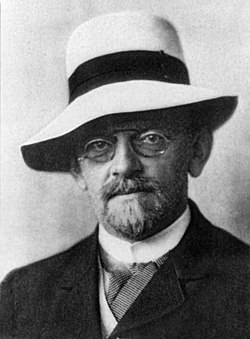
Back مسائل هيلبرت Arabic Problemes de Hilbert AST Гильберт проблемалары Bashkir Праблемы Гільберта Byelorussian Хилбертови проблеми Bulgarian Problemes de Hilbert Catalan پرسیارەکانی ھیلبێرت CKB Hilbertovy problémy Czech Hilberts problemer Danish Hilbertsche Probleme German

Hilbert's problems are 23 problems in mathematics published by German mathematician David Hilbert in 1900. They were all unsolved at the time, and several proved to be very influential for 20th-century mathematics. Hilbert presented ten of the problems (1, 2, 6, 7, 8, 13, 16, 19, 21, and 22) at the Paris conference of the International Congress of Mathematicians, speaking on August 8 at the Sorbonne. The complete list of 23 problems was published later, in English translation in 1902 by Mary Frances Winston Newson in the Bulletin of the American Mathematical Society.[1] Earlier publications (in the original German) appeared in Archiv der Mathematik und Physik.[2]
Of the cleanly formulated Hilbert problems, numbers 3, 7, 10, 14, 17, 18, 19, 21, and 20 have resolutions that are accepted by consensus of the mathematical community. Problems 1, 2, 5, 6,[a] 9, 11, 12, 15, and 22 have solutions that have partial acceptance, but there exists some controversy as to whether they resolve the problems. That leaves 8 (the Riemann hypothesis), 13 and 16[b] unresolved. Problems 4 and 23 are considered as too vague to ever be described as solved; the withdrawn 24 would also be in this class.
- ^ Hilbert, David (1902). "Mathematical Problems". Bulletin of the American Mathematical Society. 8 (10): 437–479. doi:10.1090/S0002-9904-1902-00923-3.
- ^ Hilbert, David (1900). "Mathematische Probleme". Nachrichten von der Gesellschaft der Wissenschaften zu Göttingen, Mathematisch-Physikalische Klasse (News of the Society of Sciences at Göttingen, Mathematical-Physical Class) (in German): 253–297. and Hilbert, David (1901). "Mathematische Probleme". Archiv der Mathematik und Physik. 3rd series (in German). 1: 44–63, 213–237.
Cite error: There are <ref group=lower-alpha> tags or {{efn}} templates on this page, but the references will not show without a {{reflist|group=lower-alpha}} template or {{notelist}} template (see the help page).
© MMXXIII Rich X Search. We shall prevail. All rights reserved. Rich X Search